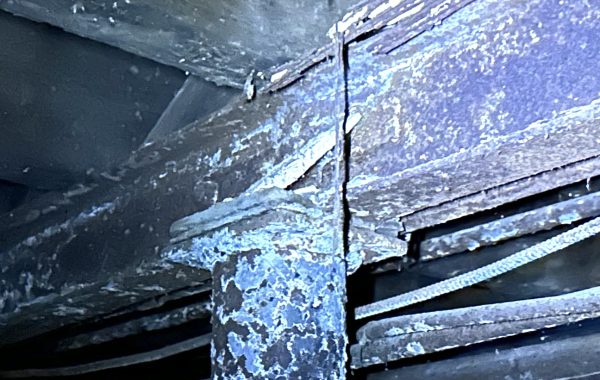I had not seen a close-up of the demolition of the Wanamaker Store at Broadway and 9th Street until I stumbled across this one, taken in September 1956 by Angelo Rizutto.

This shows the partially-intact second floor, marked on the facade by a water-table, and the last remnants of the third floor facade and interior framing. The building had burned that summer, and was being demolished.
The store had been built in 1862 as the uptown branch of A. T. Stewart and had the structure you would expect from the 1860s: cast-iron street facades, brick walls on the lot lines, wood joist floors, cast-iron interior columns and wrought-iron girders. You can clearly see all of these except the rear brick wall in this photo. You can also see how good the cast iron that was not directly exposed to fire looked after 90 years.
I’m intrigued by the way the top of every visible third-floor window is broken at the apex of the arch. It could in theory be damage from thermal movement during the fire or the stresses of demolition, but it’s unlikely. Pictures of the fire show the facades intact as the interior of the building burned and collapsed; and it’s hard to see how the workers performing the demo could accidentally destroy the arch tops without causing any damage to the rest of the iron pieces that make up the arches and the columns. It’s possible that souvenir hunters – among the workers, informally, or on instructions from the building owners, formally – had cut out the “keystones” of the iron arches, but they weren’t notably prominent or decorated, so it’s hard to see why anyone would bother. Now comes the pet theory: it was the laborers, having learned something about taking down this building on the floors above, making their lives easier. You can break cast iron by hitting it with a hammer, but that will be both unpredictable and an unpleasant way to spend your working day. You can break it with heavy machinery – a backhoe, for example – but the constrained site and the presence of the intact second floor argue against anything like that. The demo predated sawzalls and bobcats. So how do you take that facade down? If you break the arch tops, so that each column is standing independently of its neighbors, you can attached a cable to the top of the column and break it by pulling it diagonally down with a winch.
Without action photos of the demolition, or reminiscences of a worker – the youngest of whom would now be about 90 – I’ll never know.




You must be logged in to post a comment.